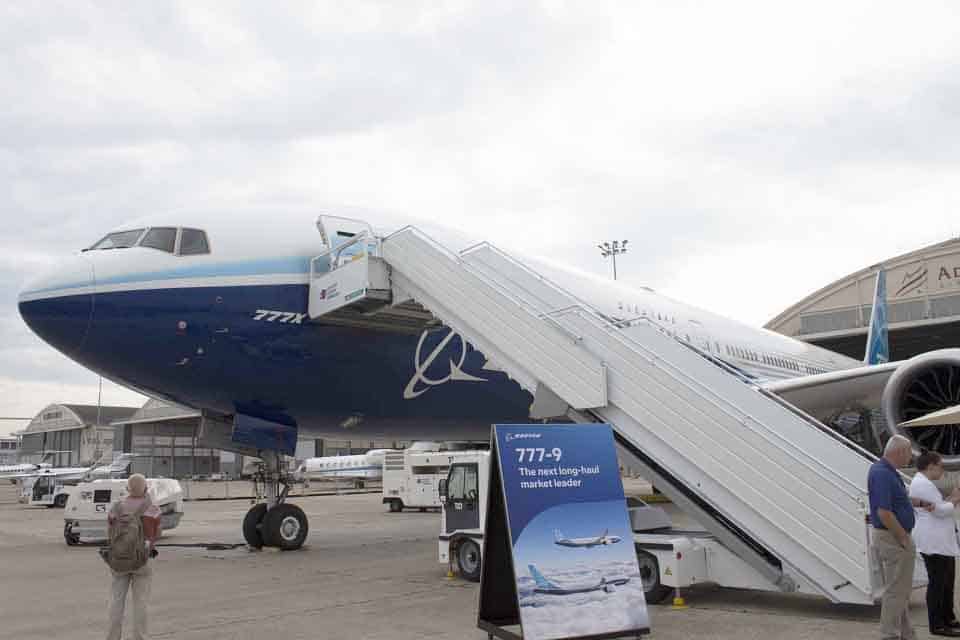Aviation
What are latest features of the Boeing 777-9 compared to the Airbus A350

The Boeing 777X, with its groundbreaking features and cutting-edge technology, stands as a pinnacle of innovation in the realm of commercial aviation. One of its standout features is the inclusion of the largest commercial airplane engine, not only boasting unparalleled size but also remarkable efficiency. This powerhouse engine significantly contributes to the aircraft’s superior fuel efficiency, leading to lower consumption and heightened operational effectiveness.
The wings of the Boeing 777X are a marvel of engineering, constructed with advanced composite materials that give them the longest wingspan in their category. This design choice not only reduces drag but also enhances the overall aerodynamic efficiency of the aircraft. Adding to this innovation is the unique folding wingtip feature, allowing the 777X to fit seamlessly into standard parking bays, showcasing a thoughtful blend of practicality and technological prowess.
The integration of multiple cameras into the Boeing 777X adds another layer of sophistication to its capabilities. These cameras serve various purposes, with dedicated testing cameras strategically positioned underneath the aircraft, marked with distinctive red coloring. These cameras capture critical footage of landing gears, tail sections, and other areas, aiding in meticulous testing processes.
Operational cameras are seamlessly integrated into the aircraft, offering a multifaceted perspective for the flight crew. The Boeing 777-10, the larger variant, boasts an impressive capacity of accommodating up to 550 passengers in its highest configuration, providing flexibility for airline operators based on their preferences. The aircraft’s windows, recognized as the largest among commercial aircraft, incorporate auto-brightness features akin to the Boeing 787, ensuring optimal passenger comfort and experience.
Despite these remarkable features, the cost factor comes into play when comparing the Boeing 777-9 with its Competitor, the Airbus A350. The Boeing 777-9 is estimated to cost around $442.2 million, while the smaller 777-8 is priced at approximately $410.2 million. In contrast, the Airbus A350-1000 is listed at $366.5 million, representing over a 10% cost advantage over the 777-8.
Furthermore, the fuselage of the Boeing 777X, constructed with composite materials, not only contributes to noise reduction and minimal vibrations but also plays a crucial role in maintaining a lower overall weight ratio. Leveraging technological advancements derived from the Boeing 787, tailored specifically for the 777X, this aircraft emerges as one of the most technologically advanced and forward-thinking options in the commercial aviation landscape.

Aviation
COMAC Unveils Plans for the C929 to Rival Airbus and Boeing

After the success of China’s first C919 aircraft, the country is setting its sights on developing a larger plane. COMAC (Commercial Aircraft Corporation of China) has officially confirmed plans to build a widebody aircraft, marking a significant step in its aircraft lineup.
Traditionally, Airbus and Boeing dominate the widebody aircraft market, with decades of expertise in developing planes and engines capable of carrying heavy payloads. China, which currently relies on imported engines, is now aiming to challenge these giants with its own widebody jet, the C929, designed to compete with the Airbus A350 and Boeing 777.
American Airlines Is Looking for Flight Attendants: Apply Now
The C929 will be China’s first independently developed long-range widebody aircraft. It adheres to international airworthiness standards and boasts independent intellectual property rights. The baseline version is designed to seat 280 passengers and offers a range of 12,000 kilometers, catering to global demand for both regional and international air travel.
Russia, which also needs reliable narrowbody and widebody aircraft, could become a key customer for the C929. Additionally, China plans to target the broader Asian market as it continues to expand its aviation capabilities.
Close Call at Heathrow: BA Flight Narrowly Escapes Drone Collision
China’s aviation progress includes the ARJ21 (now called C909), a regional jet with 100 seats for shorter routes, and the C919, a narrowbody jet with 180 seats designed to rival the Boeing 737 MAX and Airbus A320. Both models have found increasing demand in the domestic market.
At China’s largest air show in Zhuhai, COMAC announced that Air China will be the launch customer for the C929 widebody jet, though details about order size and delivery timelines were not disclosed.
Other major deals announced by COMAC include:
- Hainan Airlines: Firm orders for 60 C919 and 40 C909 regional jets.
- Colorful Guizhou Airlines: 30 C909 jets, with 20 firm orders and 10 provisional agreements.
The C929, renamed from the CR929 after Russia withdrew from the joint development project in 2023, is expected to carry 280–400 passengers with a range of 12,000 kilometers, competing directly with Boeing’s 787 Dreamliner.
According to COMAC’s deputy general manager, Tong Yu, the first fuselage section of the C929 is expected by September 2027, with prototype test flights anticipated soon after.
-

 Aviation2 months ago
Aviation2 months agoMicrosoft Flight Simulator Raises $3 Million to Bring Back the An-225 Mriya
-

 Airlines2 months ago
Airlines2 months agoQantas Engineers Stage Walkout Over Cost of Living Concerns
-

 Airlines2 months ago
Airlines2 months agoQatar Citizens Can Travel to the United States Without a Visa
-

 Aviation2 months ago
Aviation2 months agoQatar Airways bans these new Electronic Devices on plane
-

 Airlines2 months ago
Airlines2 months agoJapan Airlines Rolls Out Free Domestic Flights to International Passengers
-

 Defence2 months ago
Defence2 months agoWhich Country Has the Largest Fleet of Fighter Aircraft?
-

 Airport2 months ago
Airport2 months agoWestern Sydney Airport Welcomes Its First Plane After 6 Years of construction
-

 Aviation2 months ago
Aviation2 months agoDid you know ? Once Boeing 747 carried 1088 passenger in 1991








